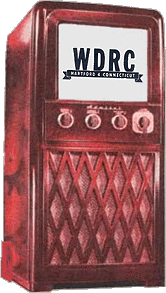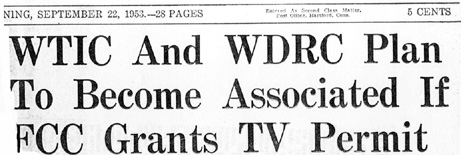
©
2003-2025
Man From Mars Productions
|
WDRC
TV
|
 |
 |
It never happened - but not for lack of trying. WDRC's founder, Franklin M. Doolittle, was a broadcast pioneer. He put Connecticut's first AM station on the air in 1922...experimented with two-channel broadcasts in 1924... obtained the first U.S. patents for binaural broadcasting in 1927...and aired the nation's first FM broadcast in 1939. It would seem logical that he would have been interested in the next developing communication technology - television. And he was. The December 1, 1939 issue of Broadcasting magazine carried an article on page 65 indicating that WDRC had applied to the FCC for a television license on 66-72 megacycles with 1,000 watts of power. The application specified that the transmitter would be atop West Peak in Meriden, where Franklin Doolittle's FM station, W1XPW, was located. An April 3, 1944 article in The Hartford Times carried the headline, "WDRC Buys Mountain Site for Postwar Television." It described the purchase of 68 acres atop Talcott Mountain, straddling Avon and Farmington, for use as "a site for a future television station and for other future radio purposes." |
|
The article went on to say Doolittle had been experimenting with television at his FM transmitter site on Meriden Mountain "for several years." He was quoted as saying he thought television would be "based on a system of relay stations which would carry images from production studios to cities many miles away." Saying "the increased output of receivers, public interest in television and adequate reception of programs point toward the need of an outlet here," Franklin Doolittle told The Billboard (Magazine) on September 20, 1947 that Connecticut Broadcasting Company would file an FCC application for a TV franchise within the month. The Hartford Courant Magazine contained an article on December 14, 1947 titled, "Humming Along in Radio for 25 Years." Among other things it said, "Mr. Doolittle and WDRC have applied for one of the two channels which have been allocated to the Hartford area. The FCC probably will hold a hearing on the Hartford allocations sometime in 1948." Being the bureaucracy that it is, the FCC delayed the process. Another Sunday Courant Magazine article on December 3, 1950, titled, "WDRC Looks Backward and Forward," said:
Unfortunately, the Doolittle TV plans suffered a setback March 2, 1952 when vice president and chief engineer Italo A. Martino died at the age of 58. The next month the FCC lifted a three-year ban on new television applications, awarding Channels 3 and 18 to Hartford. Mr. Doolittle told The Hartford Courant (April 14, 1952) he would apply for the license to Channel 3, noting, "we already have a transmitter site, building and tower on Talcott Mountain in readiness." Fast forward to December 7, 1952 - another Hartford Courant Magazine profile, called, "He Is One of Nation's Radio Pioneers." It said, "Now Doolittle and WDRC have applied to the FCC for a Hartford television channel. If the application is approved, it means the start of a new career for a man who has had a succession of the nation's 'firsts' in radio." |
 |
||
|
On September 22, 1953 Hartford newspaper headlines screamed the news that WDRC and WTIC would team up in an attempt to secure the city's first VHF television frequency. Doolittle withdrew his application for Channel 3, leaving the new partnership one opponent - Hartford Telecasting Co., headed by Clifford S. Strike, president of an engineering and construction firm. Under the agreement:
|